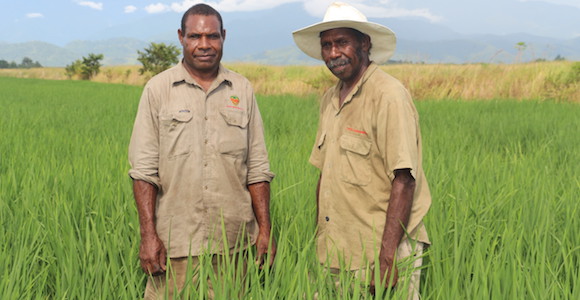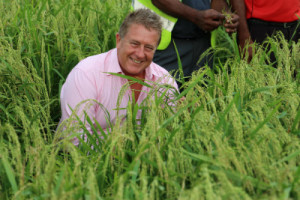With the Papua New Guinean Government remaining tight-lipped on progression of its proposed rice policy, Trukai Industries has decided to go ahead with the expansion of its rice growing business in PNG, Chief Executive Officer Greg Worthington-Eyre tells Business Advantage PNG.

David Tima, Trukai’s senior operator (left) and Michael Maran, Chingwam Cooperative chairman (right). Source: Trukai Industries
In April 2016, the National Government was reported to have signed an agreement to develop a K7 billion (US$2.2 billion) rice venture in Central Province, as part of a policy for Papua New Guinea to become self-sufficient in rice by 2030. (Most rice consumed in PNG is currently imported.)
No further details of the policy have been released since, and Trukai Industries’ Greg Worthington-Eyre says the industry is waiting to find out whether a proposed review of the policy has been implemented.
Trukai Industries, currently the dominant player in PNG’s rice market with a 75 per cent market share, recently made several submissions to government for the development of large-scale rice farming in PNG.
Worthington-Eyre says the government has not yet responded to these proposals.
With one session of parliament remaining ahead of the election, Worthington-Eyre says he is unclear as to when any decisions will be made.
Import quota
Naima, the Indonesian company allegedly awarded 80 per cent of the rice import quota in the proposed agreement, would effectively take Trukai’s market. Worthingon-Eyre says this would shut Trukai down.
‘We have made the decision that we are going to get on and grow rice regardless of any decision or lack of discussion.’
As the government continues to delay a decision on whether to implement the policy or not, Trukai Industries is seeking to expand its business by developing a rice-growing corridor adjacent to the Highlands Highway in Morobe Province.
‘We have made the decision that we are going to get on and grow rice regardless of any decision or lack of discussion,’ says Worthington-Eyre.
Plantation development

Trukai CEO Greg Worthington-Eyre. Credit: Trukai.
Trukai Industries is developing a 500-hectare rice plantation near Rangiampum, located on the Highlands Highway about two hours outside of Lae.
The proposed plantation is part of a standing agreement with the Chingwam Rice Growers Cooperation, with which Trukai Industries currently partners on an existing 80-hectare site.
‘That will give us 580 hectares in that area. And we’ve got another site up to 150 hectares to be cultivated at another location nearby,’ he says.
Trukai Industries has also recently entered discussions with the National Agricultural Research Institute to grow rice commercially in a joint agreement. Confirmation of a commercial agreement is expected in the coming weeks.
Rice growing corridor
Worthington-Eyre says the Chingwam Cooperative is a catalyst for the development of a rice-growing corridor.
Trukai Industries will harvest the rice and transport it to Lae for milling and packing.
‘The company is also in discussions to develop around 1000 hectares in the Highlands near Mount Hagen.’
This month, the company will install a hulling mill at its facility in Lae, and it is currently in discussions with the Trukai Industries’ board about investing in storage and drying facilities at selected locations along the highway.
Trukai Industries’ strategy is to develop about 2000 hectares of rice along a corridor. This includes a long-term plan, the aim of which is to use a method of irrigation to increase the frequency of crops.
The company is also in discussions to develop around 1000 hectares in the Highlands near Mount Hagen.
Unique model
Worthington-Eyre says growing rice in the Highlands requires a unique model in which the rice grown in those areas is distributed for sale within the local area.
‘Bringing rice from the Highlands down to Lae for milling is not economical, considering the cost of transportation in Papua New Guinea,’ says Worthington-Eyre.
‘If all goes well, we buy the rice from the smallholder farmer.’
‘What makes our model attractive is that we engage local people to manage our rice crops, teaching them to operate the machinery and care for the investment. Local people are also employed in the downstream processes to prepare the rice for market, adding further opportunity.’
Trukai Industries employs a nucleus model whereby the company establishes a large-scale mechanised plantation, but engages numerous smallholder farmers around that plantation to grow rice.
‘They contract to us on a smallholder basis to grow the rice variety that we need, and we help them grow it by using the central plantation as a centre for excellence.’
‘If all goes well, we buy the rice from the smallholder farmer.’
Costs
The infrastructure cost to establish a rice industry from scratch is significant and brings with it a lot of risk. Weather, logistics, poor infrastructure and road quality all add costs to the industry, reducing competitiveness.
‘The cost of setting it up from scratch is extraordinary, and it is support from local people that makes a project in Papua New Guinea sustainable. This is extremely important in any model executed, and we feel our engagement with the people is where it should be.’








Speak Your Mind